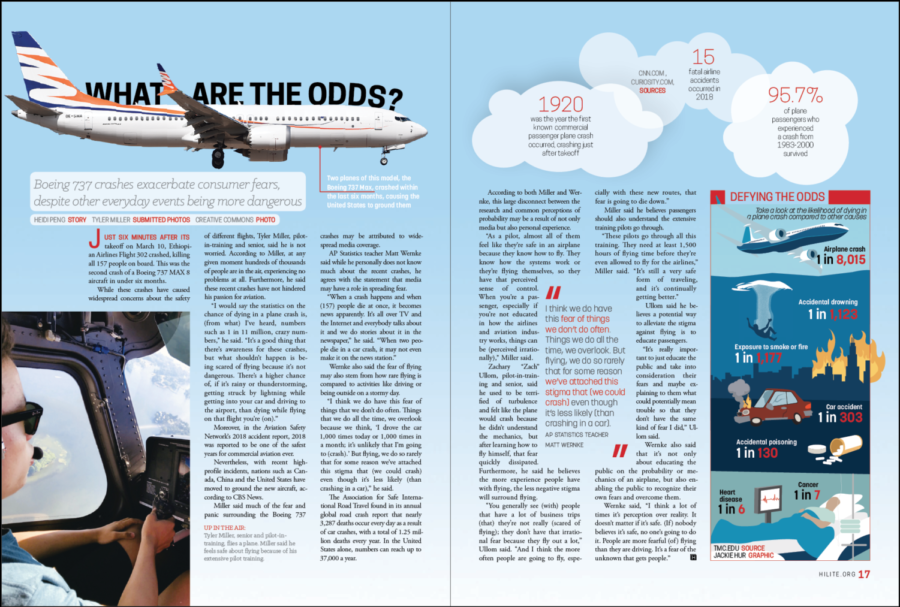Just six minutes after its takeoff on March 10, Ethiopian Airlines Flight 302 crashed, killing all 157 people on board. This was the second crash of a Boeing 737 MAX 8 aircraft in under six months.
While these crashes have caused widespread concerns about the safety of different flights, Tyler Miller, pilot-in-training and senior, said he is not worried. According to Miller, at any given moment hundreds of thousands of people are in the air, experiencing no problems at all. Furthermore, he said these recent crashes have not hindered his passion for aviation.
“I would say the statistics on the chance of dying in a plane crash is, (from what) I’ve heard, numbers such as 1 in 11 million, crazy numbers,” he said. “It’s a good thing that there’s awareness for these crashes, but what shouldn’t happen is being scared of flying because it’s not dangerous. There’s a higher chance of, if it’s rainy or thunderstorming, getting struck by lightning while getting into your car and driving to the airport, than dying while flying on that flight you’re (on).”
Moreover, in the Aviation Safety Network’s 2018 accident report, 2018 was reported to be one of the safest years for commercial aviation ever.
Nevertheless, with recent high-profile incidents, nations such as Canada, China and the United States have moved to ground the new aircraft, according to CBS News.

UP IN THE AIR:
Tyler Miller, senior and pilot-in-training, flies a plane. Miller said he feels safe about flying because of his extensive pilot training.
Miller said much of the fear and panic surrounding the Boeing 737 crashes may be attributed to widespread media coverage.
AP Statistics teacher Matt Wernke said while he personally does not know much about the recent crashes, he agrees with the statement that media may have a role in spreading fear.
“When a crash happens and when (157) people die at once, it becomes news apparently. It’s all over TV and the Internet and everybody talks about it and we do stories about it in the newspaper,” he said. “When two people die in a car crash, it may not even make it on the news station.”
Wernke also said the fear of flying may also stem from how rare flying is compared to activities like driving or being outside on a stormy day.
“I think we do have this fear of things that we don’t do often. Things that we do all the time, we overlook because we think, ‘I drove the car 1,000 times today or 1,000 times in a month; it’s unlikely that I’m going to (crash).’ But flying, we do so rarely that for some reason we’ve attached this stigma that (we could crash) even though it’s less likely (than crashing in a car),” he said.
The Association for Safe International Road Travel found in its annual global road crash report that nearly 3,287 deaths occur every day as a result of car crashes, with a total of 1.25 million deaths every year. In the United States alone, numbers can reach up to 37,000 a year.

According to both Miller and Wernke, this large disconnect between the research and common perceptions of probability may be a result of not only media but also personal experience.
“As a pilot, almost all of them feel like they’re safe in an airplane because they know how to fly. They know how the systems work or they’re flying themselves, so they have that perceived sense of control. When you’re a passenger, especially if you’re not educated in how the airlines and aviation industry works, things can be (perceived irrationally),” Miller said.
Zachary “Zach” Ullom, pilot-in-training and senior, said he used to be terrified of turbulence and felt like the plane would crash because he didn’t understand the mechanics, but after learning how to fly himself, that fear quickly dissipated. Furthermore, he said he believes the more experience people have with flying, the less negative stigma will surround flying.
“You generally see (with) people that have a lot of business trips (that) they’re not really (scared of flying); they don’t have that irrational fear because they fly out a lot,” Ullom said. “And I think the more often people are going to fly, especially with these new routes, that fear is going to die down.”
Miller said he believes passengers should also understand the extensive training pilots go through.
“These pilots go through all this training. They need at least 1,500 hours of flying time before they’re even allowed to fly for the airlines,” Miller said. “It’s still a very safe form of traveling, and it’s continually getting better.”
Ullom said he believes a potential way to alleviate the stigma against flying is to educate passengers.
“It’s really important to just educate the public and take into consideration their fears and maybe explaining to them what could potentially mean trouble so that they don’t have the same kind of fear I did,” Ullom said.
Wernke also said that it’s not only about educating the public on the probability or mechanics of an airplane, but also enabling the public to recognize their own fears and overcome them.
Wernke said, “I think a lot of times it’s perception over reality. It doesn’t matter if it’s safe. (If) nobody believes it’s safe, no one’s going to do it. People are more fearful (of) flying than they are driving. It’s a fear of the unknown that gets people.”


































![British royalty are American celebrities [opinion]](https://hilite.org/wp-content/uploads/2024/03/Screenshot-2024-03-24-1.44.57-PM.png)


















![Review: “Suits” is a perfect blend of legal drama and humor [MUSE]](https://hilite.org/wp-content/uploads/2024/04/unnamed-1.png)
![Chelsea Meng on her instagram-run bracelet shop [Biz Buzz]](https://hilite.org/wp-content/uploads/2024/04/IMG_2446-1200x838.jpg)
![Review: Quiet on Set: The Dark Side of Kids TV is the long awaited exposé of pedophilia within the children’s entertainment industry [MUSE]](https://hilite.org/wp-content/uploads/2024/04/unnamed.jpg)
![Review: “The Iron Claw” cannot get enough praise [MUSE]](https://hilite.org/wp-content/uploads/2024/04/unnamed.png)
![Review: “The Bear” sets an unbelievably high bar for future comedy shows [MUSE]](https://hilite.org/wp-content/uploads/2024/03/unnamed.png)
![Review in Print: Maripaz Villar brings a delightfully unique style to the world of WEBTOON [MUSE]](https://hilite.org/wp-content/uploads/2023/12/maripazcover-1200x960.jpg)
![Review: “The Sword of Kaigen” is a masterpiece [MUSE]](https://hilite.org/wp-content/uploads/2023/11/Screenshot-2023-11-26-201051.png)
![Review: Gateron Oil Kings, great linear switches, okay price [MUSE]](https://hilite.org/wp-content/uploads/2023/11/Screenshot-2023-11-26-200553.png)
![Review: “A Haunting in Venice” is a significant improvement from other Agatha Christie adaptations [MUSE]](https://hilite.org/wp-content/uploads/2023/11/e7ee2938a6d422669771bce6d8088521.jpg)
![Review: A Thanksgiving story from elementary school, still just as interesting [MUSE]](https://hilite.org/wp-content/uploads/2023/11/Screenshot-2023-11-26-195514-987x1200.png)
![Review: When I Fly Towards You, cute, uplifting youth drama [MUSE]](https://hilite.org/wp-content/uploads/2023/09/When-I-Fly-Towards-You-Chinese-drama.png)
![Postcards from Muse: Hawaii Travel Diary [MUSE]](https://hilite.org/wp-content/uploads/2023/09/My-project-1-1200x1200.jpg)
![Review: Ladybug & Cat Noir: The Movie, departure from original show [MUSE]](https://hilite.org/wp-content/uploads/2023/09/Ladybug__Cat_Noir_-_The_Movie_poster.jpg)
![Review in Print: Hidden Love is the cute, uplifting drama everyone needs [MUSE]](https://hilite.org/wp-content/uploads/2023/09/hiddenlovecover-e1693597208225-1030x1200.png)
![Review in Print: Heartstopper is the heartwarming queer romance we all need [MUSE]](https://hilite.org/wp-content/uploads/2023/08/museheartstoppercover-1200x654.png)






















![Review: Ladybug & Cat Noir: The Movie, departure from original show [MUSE]](https://hilite.org/wp-content/uploads/2023/09/Ladybug__Cat_Noir_-_The_Movie_poster-221x300.jpg)

![Review: Next in Fashion season two survives changes, becomes a valuable pop culture artifact [MUSE]](https://hilite.org/wp-content/uploads/2023/03/Screen-Shot-2023-03-09-at-11.05.05-AM-300x214.png)
![Review: Is The Stormlight Archive worth it? [MUSE]](https://hilite.org/wp-content/uploads/2023/10/unnamed-1-184x300.png)


